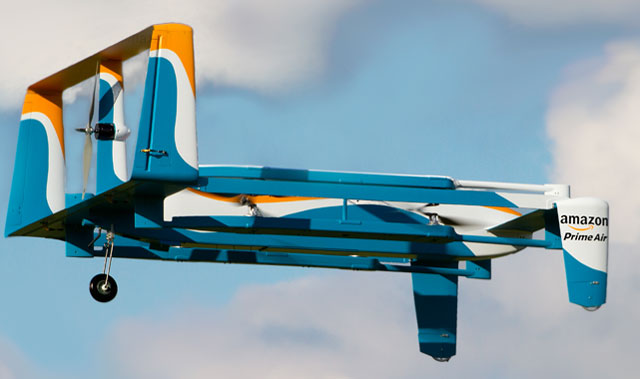
The unusual look of Amazon’s delivery drone combines elements of both fixed-wing aircraft, such as traditional passenger aeroplanes, and rotocraft such as helicopters, in a design that looks like neither. But despite its unusual looks, the boxy drone has been designed with the requirements of its door-to-door delivery duty in mind.
Rotocraft can take off and land vertically, which will be an essential requirement if the company is to deliver possibly fragile packages safely and precisely as part of its Amazon Prime Air service. The downside is their lower efficiency and range. As a hybrid of the two, the Amazon drone allows the convenience of vertical take-off and landing, and with its fixed-wing features, the possibility of smooth and quick flight to deliver packages up to around 24km away within 30 minutes.
The rotary element includes eight propellers organised in four pairs of coaxial rotors — where one is mounted over the other — in a quadcopter layout. These are fitted to two horizontal booms, one to either side of the drone’s central torpedo-like fuselage which carries the packages and the batteries to power it. Coaxial rotors are less efficient than single rotor propellers and they require about 40% more power for the same thrust. But they do provide larger thrust for a given rotor area — a way of packing the most thrust into a small-bodied aircraft.
The basic principle behind a quadcopter layout is that thrust produced by each of the propellers can be controlled independently to stabilise the attitude of the vehicle. Unlike a helicopter, manual control of a quadcopter is practically impossible. The reason that quadcopters have become so popular — and easy to fly — is only due to the rise of affordable autopilot systems that intelligently monitor and stabilise the drone.
The fixed-wing aspect of the drone is composed of two wings. The rear wing is a box wing design, incorporating three vertical tail fins, one with a horizontally-mounted propeller. While rarely used, box wings are theoretically more efficient than conventional wings due to the reduction of what is known as vortex-induced drag.
This drag occurs due to the high-pressure air on the wing’s lower surface escaping around the wing-tips, reducing the effectiveness of the wing. In order to work around this, the box wing design provides a continuous surface that blocks the movement of air from lower to upper surface. Winglets on conventional aircraft are designed to play a similar role.
The box wing also has some structural advantages, but in practice there are aerodynamic trade-offs which mean it is normally discarded in favour of large wing spans. In Amazon’s case, the box wing design provides the necessary lift in an aircraft that’s also small — so that it’s easier to land in your garden.
The front wing also features winglet-like fins to reduce drag, only these are inverted to point downwards so that they can also double as a place to fit the landing gear, two wheels, in a way that doesn’t create excessive additional drag.
Conventional fixed-wing aircraft usually have their wings set more or less centrally between the nose and tail, whereas the wings of this drone are positioned at the extreme front and rear, giving the aircraft its curious square appearance.
For an aircraft to be stable and safe to fly, the centre of mass must be positioned in front of the centre of lift. On a conventional aircraft, the centre of lift is roughly aligned with the main wings and the aircraft’s weight is nearer the nose. The centre of mass for Amazon’s drone will probably be close to the centre of the aircraft to ensure it is balanced when operating in vertical flight. The use of a larger wing area at the rear will help to bring the centre of lift backwards, behind the centre of mass, to ensure it remains stable in forward flight.
For its control surfaces, the drone has elevons — a combination of ailerons (which control aircraft roll) and elevators (which control pitch). When synchronised, they can be used to control the aircraft’s angle of pitch up or down, and when moved in opposite directions, they control the roll of the aircraft. This design is another decision that potentially reduces mass, cost and complexity, although potentially at the cost of control.
The aircraft is one of several prototypes being evaluated by Amazon, and shows some interesting concepts. Inevitably, there’s a difficult compromise to be struck between the need for vertical take-off and landing and forward flight efficiency. The wings and control surfaces add extra weight, reducing flight time, while the rotors, their motors, and the extra structural elements they require will add more weight and drag, reducing its range. It will be interesting to see how Amazon balance these conflicting requirements as their designs progress.![]()
- Pejman Iravani is lecturer in mechanical engineering, David Cleaver is lecturer in aerospace engineering and Jonathan du Bois is lecturer in electromechanical engineering, all at the University of Bath
- This article was originally published on The Conversation

